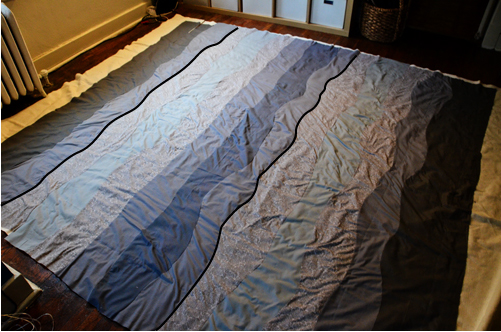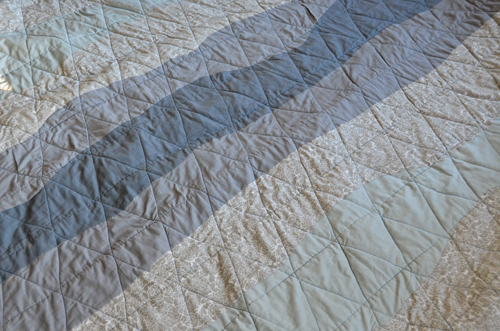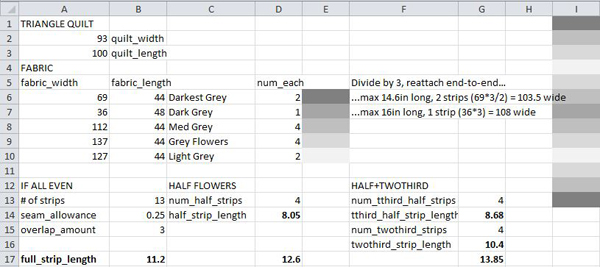Spatial Reasoning Through Textiles

Freeform waves quilt backing, with two curves accentuated in post-processing
Description
Spatial reasoning ability has been connected with success in Science, Technology, Engineering, and Math (STEM), and this relationship has been documented repeatedly. There's an interesting article by Wai, Lubinski, and Benbow (2009) about this topic, where they've done an analysis on longitudinal data examining how spatial ability influenced people's university and career choices over 15 years. The results were generally what one would expect: spatial ability leads to higher success within STEM, although females with high spatial ability tended to be more interested in the arts while the high ability males preferred engineering and mechanical activities. All this is to say that spatial reasoning is part my reasons for becoming a computer scientist, and I have my suspicions about where I obtained the most practice in spatial reasoning: sewing. Whether this is an artistic or engineering pursuit, is unknown. Perhaps a little of both as we'll see shortly.
As an example, recently I brainstormed up an idea for the back of a quilt I was constructing, when I encountered a wall of algebra. It is another example to add to the "practical math" pile, alongside calculating waitstaff tip and retail sale prices. Creating wavy seam lines on a flat piece of fabric is not the most intuitive process, but it becomes trickier with constraints on fabric quantities. The fabric store ran out of the shades I needed, so I had to set up some equations in Excel to ensure I had enough fabric. The basic questions being: (1) Do I have enough fabric to make a wavy gradient effect? and (2) How tall should/can each row of the gradient be?

Layout. The gradient effect would start at the darkest shade, become lighter, then darker, then lighter, then dark again. I had 5 shades of grey, but not enough of the two darkest shades so let's pretend it's just four shades. This yielded a gradient made of 13 rows of the fabric (i.e., dark, medium, floral, light, floral, medium, dark, medium, floral, light, floral, medium, dark). So I would need 3 dark strips, 4 medium grey strips, 4 floral grey, and 2 light grey rows.
| 13 | 3x dark, 4x medium, 4x floral, 2x light |
Dimensions. The quilt dimensions were 98" X 101", and each piece of fabric was 44" wide and 100"+ long, so it seems that most of the fabric was wide enough (i.e., 98"+). In the cases where they weren't, as in the dark grey fabrics, I had to cut them in thirds length-wise, yielding 3 pieces about 14.6" tall. These three pieces were then sewn together end-to-end, creating a strip that is long enough. In the case of the darkest grey, this 207" long strip was cut in half to make two strips of appropriate size for the end of the gradient.
| Quilt dimensions: 98" quilt width X 101" | 44" X 100"+ fabric dimensions |
| Darkest grey strips are 14.5" X 207" (44/3 X 69*3) | |
| Dark center grey is 16" X 108" (48/3 X 36*3) |
Seam Allowance. When sewing two pieces of fabric together, you typically lose 1/4" of fabric from both pieces. This is called a quarter inch seam allowance. So, in the case of the center dark grey strip, it would lose 1/4" on its top and bottom when sewn, due to the seam allowance. This means that at most, the center dark grey strip would be 14" tall (14.5-0.5).
Curve Overlap. It turns out that if you want to sew freeform wave seams into fabric, according to Lily's Quilts' lovely tutorial for smaller projects, you need to overlap the two fabrics by a certain amount. When you cut the freeform waves, you cut them only in the overlap, so you end up losing the
| 1/2" of height of each strip lost to 1/4" |
| 3" |
Calculations. Since we know our fabric is wide enough (100"), we're just trying to determine if our fabric is tall enough, considering the amount we lose due to seam allowances and the freeform waves. The formula used to determine how tall each strip needs to be (assuming equal height/length) is in the Calculations Table below.
Since I used an overlap of about 3 inches, my math told me I need the 13 strips to be about 11.25" tall. But let's say we wanted the floral grey strips to be half the length of the other strips. Or what about making the floral grey strips half length and the medium grey strips two-thirds length? There is algebra for that...
| Calculations Table | |
|---|---|
| Equal Strips | |
| Floral Half Strips | |
| Two Third Strips | |
| Explanation | The term following |
| Check Math | For each strip length, substract |
We're basically dividing the the total quilt length by the number of full length strips, and then adding the seam allowance and overlap amounts to this minimum 'showing' amount. In the first case, that is pretty direct, but as half and two third strips are included it becomes slightly more complex. In the half strips example, the 4 floral grey half strips would have to be around 8" tall, and the full strips would have to be about 12.75" tall. When each strip loses its 3" overlap and 0.5" seam allowance, these two numbers are indeed half/double. I did this all in Microsoft Excel, since it's fairly straight forward math, with the aid of a little gradient visualization to help picture the design:

Evaluation. To determine if these strip heights are possible, I just calculated the maximum strip height for each color of fabric by dividing the fabric length by the number of strips they need to produce. What we see is that our medium grey fabric is the limiting factor here, and those strips cannot be taller than 11". So, we basically have enough fabric to do equal-sized gradient strips, but not quite enough medium grey fabric to do the floral half strips plan. Of course, I could make the light grey and dark greys slightly taller to make up for the lack of medium grey. For this, a different equation could be drawn to make the 4 floral strips half length, the 4 medium grey strips 2/3 length, and then everything else equivalent heights (i.e., the last set of equations in the Calculations Table).
| 14.5" (44/3) max length darkest grey | 11.25" length needed for equal strips 12.75" length needed for including half strips 14" length needed for half + two third strips |
| 16" (48/3) max length center dark grey | |
| 11" (44/4 strips) max length medium grey | |
| 11" (44/4 strips) max length floral grey | |
| 22" (44/2 strips) max length light grey |
Conclusion. I ended up using approximately equivalently sized strips for my project. Although, in hindsight I really should've gone for the bolder option of the half+two thirds combination. I had just barely enough medium grey and light gray fabric to have done almost any combination of strip lengths. It was strip lengths longer than 11" that could complicate matters. The real question becomes if these slight differences in strip lengths would even be noticeable in the final product. Not that anything is noticeable on the back of a quilt!
